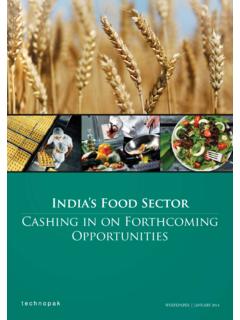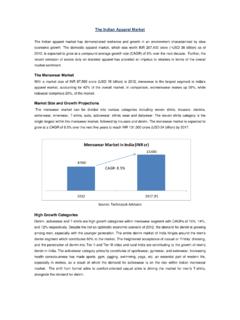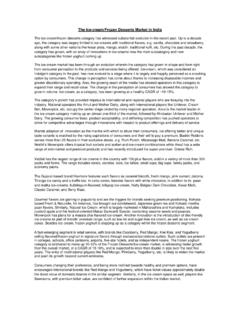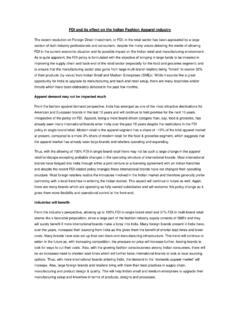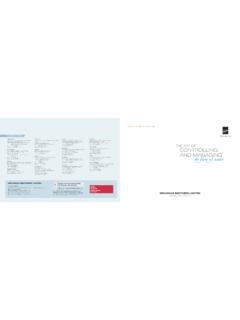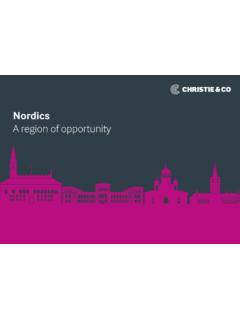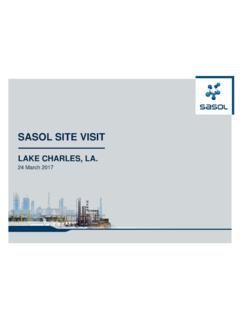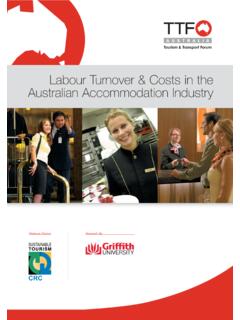Transcription of Branded Coffee Market in India - Technopak
1 Branded Coffee Market in India Traditionally, the Coffee consumption in India has been largely concentrated in the southern region which also contributes ~90% of the total domestic production. The availability of fresh Coffee , at an affordable price, is the major driver for the high levels of domestic consumption in southern India . However, in the past two decades, there has been a spread in Coffee consumption to other parts of India , even if largely in urban centers. This penetration of Coffee consumption is not restricted to the beverage alone but also in other forms like desserts and ice-creams. The increase in disposable incomes, the higher number of double income households, more global exposure, the increasing media penetration and attention to food, the rapid urbanization and changing lifestyle preferences, influenced by the western world, along with a greater number of modern retail outlets stocking a larger variety and more variants of Coffee , and new product developments by national and international players have boosted the consumption of Coffee in other parts of India .
2 India is the world s sixth largest producer of Coffee , with a production of 304 thousand metric tons (MT) in 2013, of which 125 thousand MT is the domestic consumption1 with the per capita consumption being ~90 gm per year. The major channels for domestic trade are modern, traditional retail, and national and international caf chains. The retail Coffee trade is largely dominated by Branded players, with Nestl and Hindustan Unilever being the category s leaders accounting for approximately 60-70% of the retail Market (by value) in 2012. Other brands include Tata Coffee and regional players like Narasus, Cothas, and Leo s which compete strongly in the respective markets. 1 Source: The Coffee Board of India Coffee Trade Exports Domestic Market Branded Food Service Outlets (Private Labels of Caf Coffee Day, Starbucks, etc.)
3 Retail Market (Modern trade, Traditional trade) The Coffee Trade: Retail Market Construct The channel which contributes most to the sales of Branded , packaged Coffee is traditional retail, large and/or small kirana stores accounting for approximately 70% of the total sales (by value). Modern retail contributes approximately 20-25% of total retail sales. The Market for packaged Coffee constitutes different variants, shown below. The Market for filter Coffee is predominantly southern India where the competition from local/regional player is considerable. These players sell pre-packed or customized variants of pure Coffee or of Coffee -chicory mix. This model has been replicated by organized players like Caf Coffee Day s Fresh n Ground, to grab a share of the existing Market .
4 On the other hand, instant Coffee is highly popular in all other regions of India , which has propelled brands like Nestl to innovate and produce packaged variants of exotic Coffee beverages in ready-to-drink (RTD) formats, instant cappuccino packs. The increasing acceptance and appreciation of Coffee as a beverage, in all parts of the country, has encouraged the established brands in this category to launch exotic ranges to provide a heightened experience to their patrons. Hindustan Unilever has launched different flavors, Bru Exotica Brazil, Bru Exotica Columbia, and Bru Exotica Kilimanjaro as an extension of their product offerings to capitalize on a premium range. HUL and Nestl together have a wide range of Coffee powders, varying from Nescaf Gold (priced between INR 4000-4500 per kg) to Bru (Green Label, at INR 250-275 per kg) to cater to all classes of consumers.
5 Additionally, the Market for decaffeinated Coffee is also garnering attention and growing at a rapid rate. The increasing awareness about health and wellness has pushed the attention of health-conscious consumers towards decaffeinated Coffee . Nestl has launched its Gold Blend decaffeinated Coffee to tap this emerging Market . The RTD Market for Coffee -based beverages is likely to grow, although it is currently at a very nascent stage, making up less than 1% of the total Coffee Market in India (by value). It is largely serviced by instant packs marketed by international players, Nescaf Cappuccino packs, and by caf chains like Starbucks who are retailing their Private Labels. VARIANT BRANDS Price Range Instant Coffee ( Coffee Powder) Nescaf Sunrise, Classic, Gold Bru Green Label, Instant, Super Strong Gold, Exotica Illy Lavazza INR 250-Rs 4500 per kg Premixes Nescaf Cappuccino, Vanilla Latte, Choco Mocha Bru INR 60-75 per pack of 5 Pods Nespresso, Lavazza, Fresh n Honest INR 30 each upwards Beans Illy, Lavazza, Coffee Day, Starbucks, Coffee Bean n Tea Leaf, Fresh & Honest INR 500-Rs 5000 per kg Ready-to-Drink (RTD)
6 Starbucks, Nescaf Amul, Mother Dairy INR 20-275 per bottle Filter Coffee Kaapi INR 750-800 per kg The past two decades have introduced urban consumers to bean-to-cup Coffee thanks to the surge in caf formats, as well as the increasing proliferation of Coffee vending machines in such institutions as offices and commercial organizations, who now prefer unmanned machines to service the needs of their employees in terms of stimulating beverages like tea and Coffee . Brands like Fresh & Honest and Caf Coffee Day are the leaders in this category. Illy, Lavazza, and Caf Coffee Day are the prominent players in the Branded space for packaged Coffee beans. However, the domestic use of Coffee beans is limited as they require the use of such brewing equipment as Coffee grinders/percolators which still have a low penetration in homes.
7 The increased acceptance of Coffee can also largely be attributed to the growing caf culture with brands like Caf Coffee Day and Barista opening outlets across the nation, which appeal to the young urban population as a popular hangout place. Caf s have not only widened the awareness of Indian consumers vis- -vis popular variants of Coffee drinks cappuccino, mocha, latte, espresso, Americano, etc. but also introduced them to more exotic and innovative drinks like espresso, macchiato, affogato, etc., different kinds of frapp s, and a multitude of add-on flavors. The increasing interest in the bean has led to more international Coffee variants being offered in upmarket caf s at a premium. As a result, the best coffees worldwide, Brazilian, Ethiopian, Columbian, Guatemalan, etc.
8 Are being served and consumed with lan. The growth and success of these brands have in turn stimulated the appetite of other international players like Costa, Starbucks, and The Coffee Bean & Tea Leaf to venture into the Indian Market . The surge in the number of caf s has strongly contributed towards making India a Coffee loving country . However, the geographic penetration of Coffee is largely limited to the urban population in Metros, Mini metros, Tier I and Tier II cities, excepting southern India . Additionally, the emergence of caf s has also elevated the urbane image of Coffee . With approximately 70% of the Indian population living in rural areas, it is imperative that players offering packaged brands stress on penetration into the rural Market .
9 The challenge lies in generating appeal among the rural consumers, who are traditionally tea drinkers, and in creating scope for a shift in their preference. However, with the past, and forecasted, growth in this category, the future for packaged Coffee brands is promisingly healthy. Authored By: Tarun Jain (Vice President, Food Services & Agriculture) Reetesh Shukla (Associate Director, Food Services & Agriculture)

